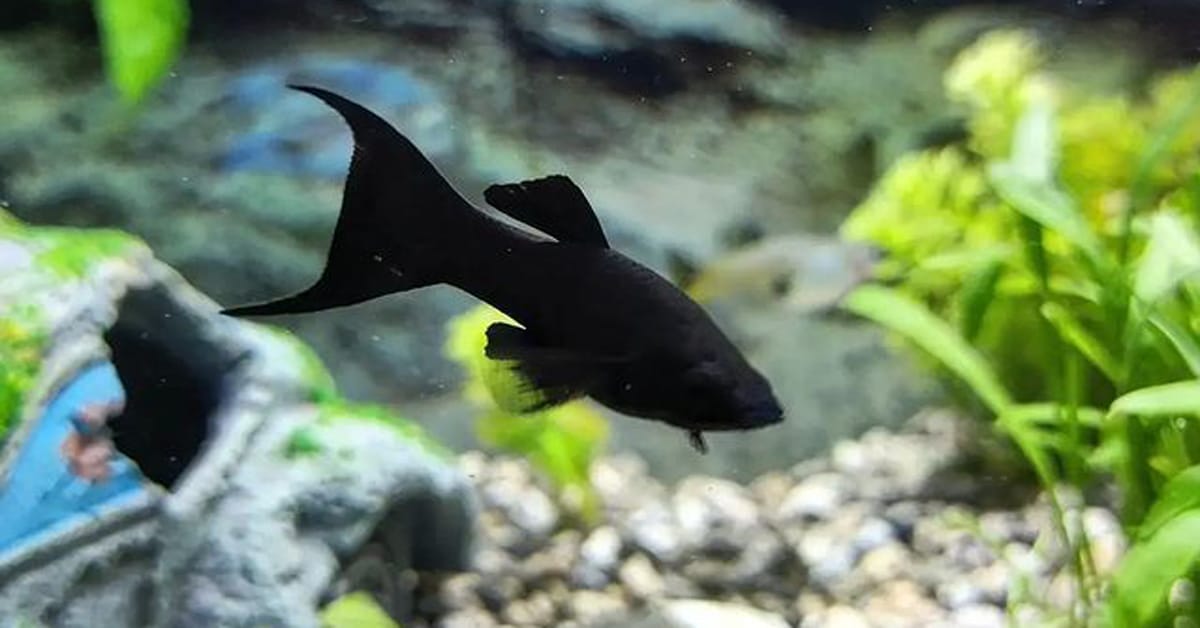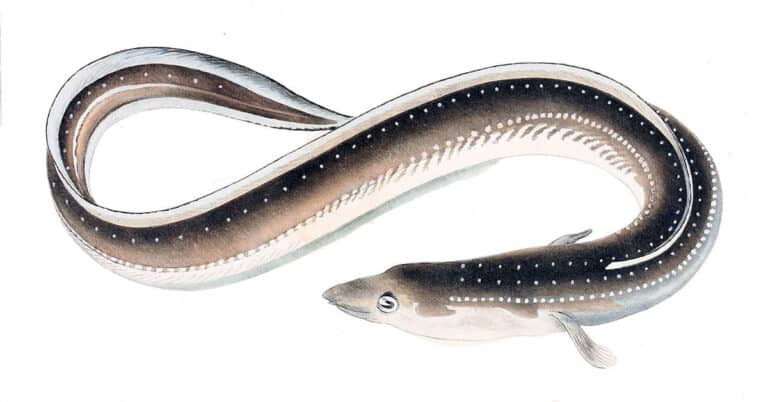Black Molly
Scientific Classification
| Kingdom: | Animalia |
| Phylum: | Chordata |
| Class: | Actinopterygii |
| Order: | Cyprinodontiformes |
| Family: | Poeciliidae |
| Genus: | Poecilia |
| Species: | P. Latipinna |
| Binomial name: | Poecilia latipinna |
The Black Molly is a hybrid variety of Poecilia Lalipinna, having short fins. It is also called sail fin molly. This short-finned Black Molly is totally black in color. At the juvenile stage, it is likely to possess patches of silver or gold on its body. As age advances, these patches disappear. The Black Molly is capable of adjusting to different levels of salt in the aquarium water. As a healthy procedure, you would do well to add a teaspoon of aquarium salt to every gallon of fresh water, in the aquarium.

Habitat
The habitat of the Black Molly extends from the North of Colombia and Venezuela to Mexico and some secluded places on certain Caribbean islands. Nowadays, in the hobby market, we rarely find the wild fish. The majority of those sold are produced in bulk in the distant eastern provinces and East of Europe. In countries like Singapore, Japan and also the regions of Eastern Europe, there are hardly any that are brought to the feral population.
The main places, from where the Black Molly comes are from the fish farm and are mostly those bred in aquariums. Prior to breeding, feed your Black Molly sufficiently well. The Black Molly is a Livebearer, it eats its fry, and therefore it is essential that you place floating plants in your aquarium for the fry to hide from view, in your absence, when the Black Molly delivers the fry. As soon as you notice the fry swimming, remove them into a separate tank or put them in a breeding net.
Description
The Black Molly is also termed the Midnight molly, obviously due to its color. As the name suggests, the whole body of this fish is black. The main reason for the black shade is the melanistic condition. This is a condition where the melanin or the pigmentation of the skin is present in its full potential and results in a very dark skin color. The normal size of a male Black Molly is 3.2 in. (8 cm.) and that of the female is 4.8in. (12 cm.)
Breeding
In the case of the Black Molly, copulation is not an issue. The female Black Molly is bigger than the male and its anal fin is triangular in shape, whereas the male is smaller and it has a gonopodium, which is an adapted anal fin. The use of it is to hook the female and disperse its sperm.
In the Molly tank, generally, breeding occurs naturally. If you are certain that the ration of male and female is 1:2, then without delay you will notice pregnant Black Mollies in the tank. The identification mark of the pregnancy is a dark colored gravid spot close to its anal fin. And the stomach will be considerably bloated.
Like in other species, the Black molly too, undergoes certain courtship rituals before mating. The male Black molly displays its fins to attract the female. These female Molly fish are capable of getting pregnant many times after mating, because they can store the sperm in their body, leading to pregnancy again after a few weeks of giving birth. A female Molly is capable of giving birth to around 60 fry in every two and a half month. When a female gets pregnant, immediately separate her from the male fish or the male will keep on mating even in her fragile state. This process can add stress to the female fish and can lead to miscarriage. So it is safe to place her in a well arranged birthing tank.
Fry And Its Care
After birth, the fry, try to hide and settle down between the plants. It is said that the Mollies are neither very concerned or are they good parents. They often see their fry as food. Hence, it is essential to keep the parents away from the babies. The fry should be grown separately in another tank. Provide essential nutrients through food for healthy Molly species. You can provide them a diet of flakes in crushed form, as well as live food like newly born brine shrimp or small micro worms that are good for their physical development. Provide food around 3 to 4 times a day in the beginning for a few weeks to ensure proper nutrients for their growth. The water should be partially changed, once on alternate days.
Tank
For the Black molly the minimum size of the tank is a 20 gallon one. The stability of the water increases as the tank is bigger. The Black Molly takes pleasure in skimming the surface of the water by its mouth, searching for food, therefore use a filtration that will not create a disturbance to the surface of the water. To maintain the water to a perfect temperature, place a heater in the tank. See that you have non aggressive fish in the tank. Remember that there is a possibility of your fish becoming a prolific breeder; as such when you rise up one day, don’t be startled to find tiny black dots swimming about.
Water condition
The ideal range of pH is 7.5 to 8.2 and that of the temperature of the water is 70 to 82 F. The Black Molly moves from the middle to the top, and eats the green algae in the water.. You can also feed the Black Molly with dried feed floating at the top. The fish also eats frozen food, of vegetable base and also a balanced diet of vegetables, like cucumber and lettuce. The Black Molly flourishes well in aquariums that have plenty of plants.
Nutrition
The Black Molly is, by nature omnivorous. It eats different types of natural food like detritus and zoobenthos. It eats mostly all the food you give it, however, give them vegetable products like vegetable flake or blanched spinach as the major portion of the diet.
Setup
The difference between the male and the female Black Molly is that the male has a pointed anal fin and a very big dorsal fin, whereas the female fin is rounded and when pregnant, it has dark spots. The Black Molly needs a spawning box in the breeding tank of 20 gallons or even bigger.. Either form a thick algae mat or have densely packed plants in the tank. If you have a thick growth of plants in the corner of the tank, it enhances rearing Black Molly out of the breeding tank. The female delivers every 60 to 70 days, bringing out 10 to 60 fry that are almost ½ “ long at birth.

Having discovered a fondness for insects while pursuing her degree in Biology, Randi Jones was quite bugged to know that people usually dismissed these little creatures as “creepy-crawlies”.







